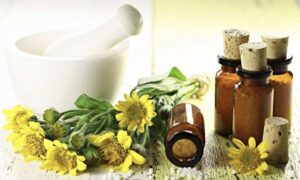Maca root, or “Peruvian ginseng,” has a colorful history in Latin America that spans more than 2,000 years. Maca is cultivated at high altitudes and under harsh conditions in the Peruvian Andes. Legend has it that Incan warriors ate it to increase their stamina in battle, and the region’s indigenous people have long used it as a staple food and to increase fertility.
In modern times, maca has found its way onto the supplement shelves of many health food stores as a result of aggressive marketing campaigns, but more research is necessary regarding the list of conditions that it is purported to help. Let’s break down what we know—and what we don’t.
Prized as a Superfood
As one of the few crops able to grow well in very high altitudes and extreme conditions, it’s no wonder this cruciferous vegetable has been prized for centuries by people indigenous to the Peruvian Andes.
Maca is part of the Brassicaceae (mustard) family of plants and is related to cauliflower, cabbage, and kale. It has traditionally been eaten by the natives of the Peruvian highlands as a highly nutritious staple food, containing protein; fiber; amino acids, including most of the essential amino acids; minerals such as iron, zinc, calcium, and copper; and vitamin C and antioxidants.
Maca comes in a spectrum of colors, but research has focused primarily on yellow, red, and black maca—each with distinct benefits, according to some experts. According to a 2020 review published in the Royal Society of Chemistry, yellow maca is the most widely researched. It’s used to increase energy, balance hormones, and boost cognitive function.
Red maca, because of its alleged hormone-balancing properties and positive effects on bone health, is thought to be most effective for women.
Black maca is the rarest of the maca colors and is thought to be particularly effective for men, especially for muscle gain, stamina, concentration, and libido.
However, it is important to note that research on the specific benefits attributable to the different colors of maca is limited. Also, many supplements available for consumer purchase do not specify the color of maca used, making it difficult for an individual to choose a supplement for personalized benefit.
Lowers Stress, Boosts Mood
Maca root is an adaptogen, a term that describes a category of non-toxic herbs that help the body adapt to external stresses and regain balance.
Jose Antonio, professor of Health and Human Performance at Nova Southeastern University, told The Epoch Times that “adaptogens are thought to affect the body’s stress response by influencing the hypothalamic-pituitary-adrenal (HPA) axis and improving resilience to physical, mental, and emotional stress.”
Some of the research on maca has supported this adaptogenic role in animals. A Chinese study performed on rats, published in the May 2019 issue of Journal of Food Science & Technology, gave one group of rats a maca ethanolic extract every day for three weeks and then exposed them to “chronic unpredictable mild stress.” The rats treated with maca extract produced lower levels of the stress hormone cortisol than the groups of rats not treated with maca extract, leading researchers to speculate that “maca ethanolic extract might have regulatory properties against chronic stress.”
Although few human studies exist, there is some evidence that maca may also have positive effects on postmenopausal women, reducing depression, anxiety, and sexual dysfunction.
Increases Libido, Enhances Fertility
One of the most widely reported benefits of taking maca is that it is believed to increase libido in both men and women.
Despite maca’s growing popularity and plenty of supporting anecdotal evidence, the research backing these claims is limited.
A 2023 systematic review published in Journal of Men’s Health examined the effect of maca on men with mild erectile dysfunction (ED). Two randomized control trials were used, and researchers found limited and inconclusive results. The first trial, which included 50 men, found significant differences between the maca-supplementing participants and the placebo group, but the second trial (of 32 men) found no notable differences between the groups.
The study authors concluded that there is “limited evidence” that maca supplementation has a positive effect on men with mild ED, but the evidence is insufficient to draw a firm conclusion.
Balances Hormones
Maca is believed to support hormonal balance in women.
Triple board-certified OB-GYN Anna Cabeca writes on her website, The Girlfriend Doctor: “Maca root is one of my all-time favorite tools for balancing and supporting perimenopausal and menopausal hormones. Maca ... encourages balance within the endocrine system, which controls hormone production.”
For men, supplementing with maca does not increase testosterone levels, but it may help support the endocrine system, which helps keep hormones in balance.
Boosts Energy
Maca is frequently taken for its alleged energy-boosting properties, including by athletes seeking to reduce fatigue and improve their performance and by people looking for a caffeine-free boost.
Studies on
mice have found that maca may help reduce exercise-induced fatigue.
A 2022 randomized, placebo-controlled, double-blind Japanese study involving adult women divided 60 participants into two groups. One group consumed 9.6 milligrams per day of maca extract containing benzyl glucosinolate, and the other group took a placebo. The women were evaluated for fatigue via questionnaire, scoring their level of fatigue on a scale between zero and 10. After four weeks, the levels of fatigue were reduced in both groups, but in women under 45 years of age, the lowest levels of fatigue were recorded among those taking the maca extract.
Precisely how maca acts as an energizer is unclear, but researchers speculate that the effect may be caused by maca’s strong antioxidant properties, which reduce oxidative stress, or its positive effect on mitochondrial function and energy metabolism.
Possible Risks
According to
health authorities, maca is considered to be generally safe, with very few adverse effects.
Antonio said, “Side effects are rare, though some experience GI issues.”
Dosages of maca used in studies have typically ranged from about 1.5 grams per day to 3.5 grams per day, but an optimal dosage has not been established. According to the National Library of Medicine, doses of up to 3 grams of maca daily for up to four months seem to be safe.
Higher concentrations may not be, though. A 2020 review noted that, in adult rats that experienced stroke, high concentrations of methanolic extract of maca increased brain damage, suggesting that maca may be toxic in high doses.
Also, Consumer Lab tests of maca supplements found one consumer maca product to be contaminated with lead in concentrations high enough to prohibit its approval.
The U.S. Food and Drug Administration has also reported that certain maca supplements that have been marketed as improving sexual function have contained pharmaceutical drugs used to treat erectile dysfunction. Making sure that any maca you consider buying has been tested for contaminants by an independent third party can help alleviate these concerns.
It is unknown whether maca interacts with any medicines and whether it is safe for use by pregnant or breastfeeding women. Also, those with hormone-sensitive conditions such as breast cancer or endometriosis should steer clear of maca. The National Library of Medicine warns: “Extracts from maca might act like estrogen. If you have any condition that might be made worse by estrogen, do not use these extracts.”
Takeaway
Although maca root appears to offer many potential benefits and has a strong safety profile for use in healthy adults, more research is needed to ascertain whether its alleged benefits are really as good as they sound.














